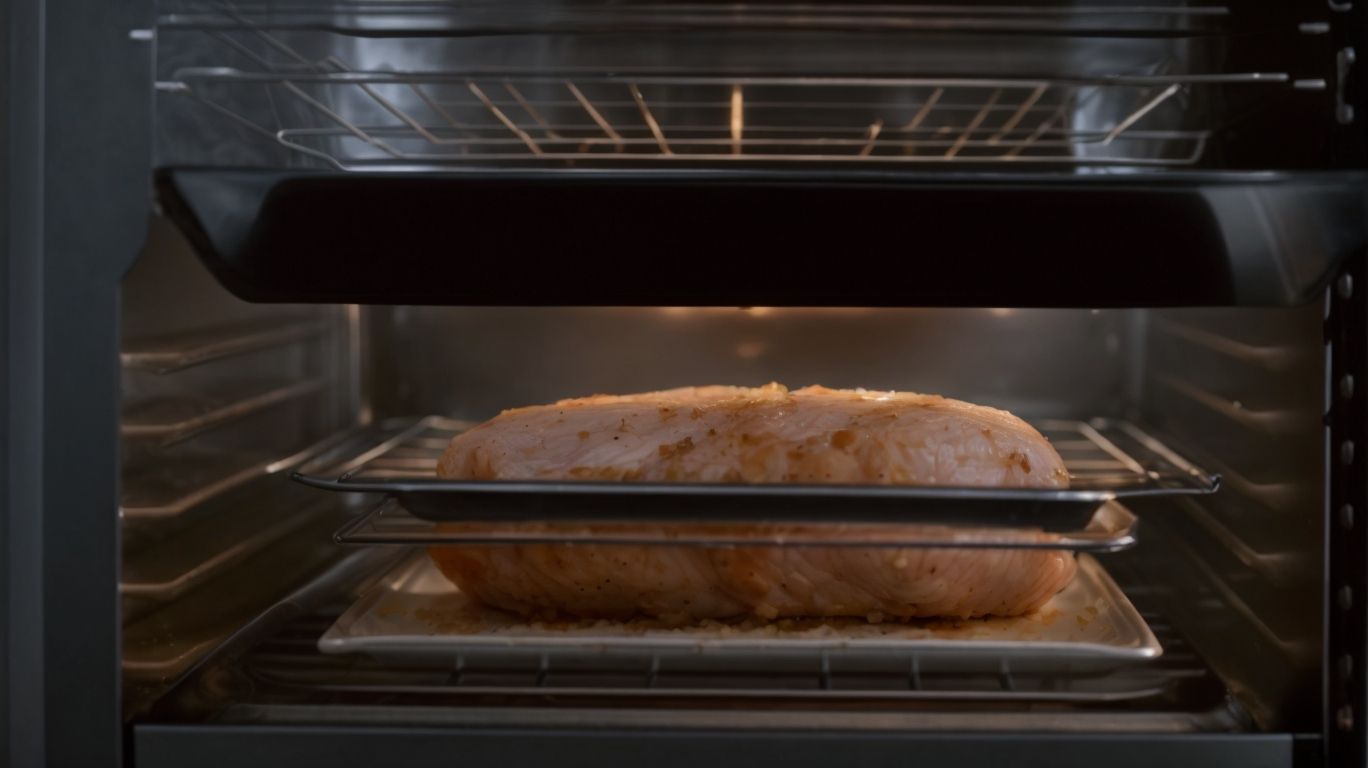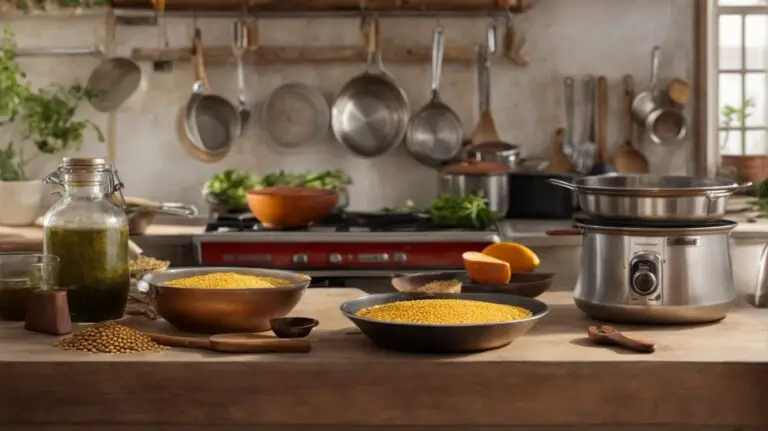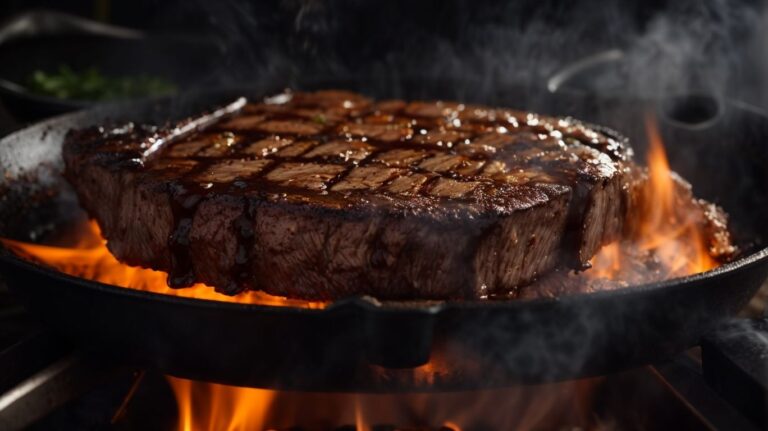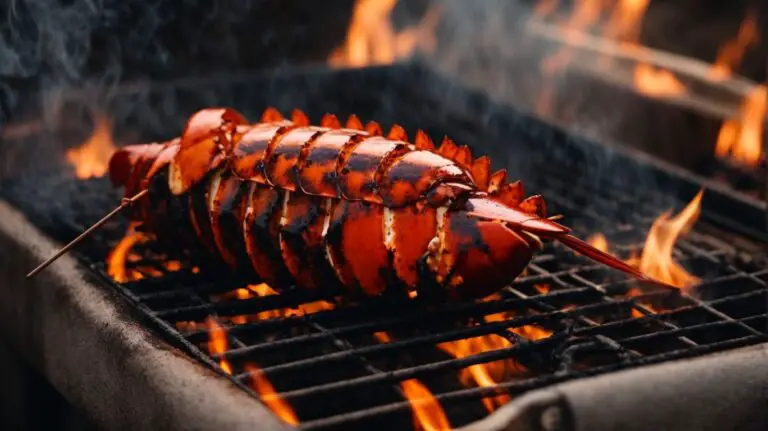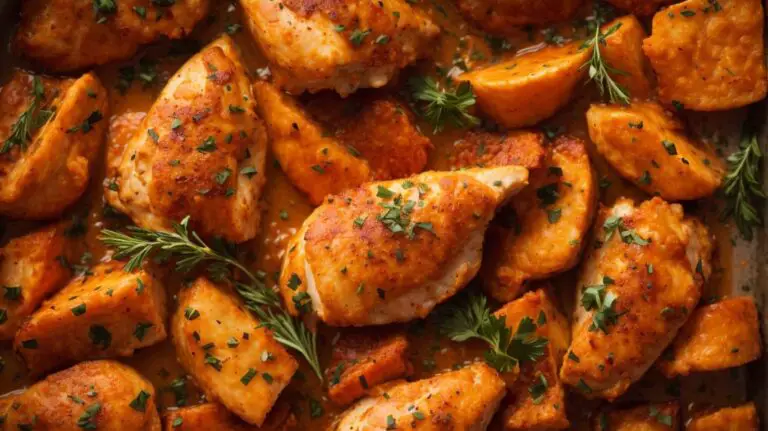How to Cook Chicken Breast Under Broiler?
Are you looking for a quick and easy way to cook chicken breast to perfection? Look no further than using a broiler!
In this article, we will explore what a broiler is and how it works. We will also discuss the benefits of cooking chicken breast under a broiler, as well as the tools needed for the job.
We will provide step-by-step instructions on how to prepare and cook chicken breast under a broiler, along with some helpful tips for a delicious result. Let’s get cooking!
Key Takeaways:
What is a Broiler?
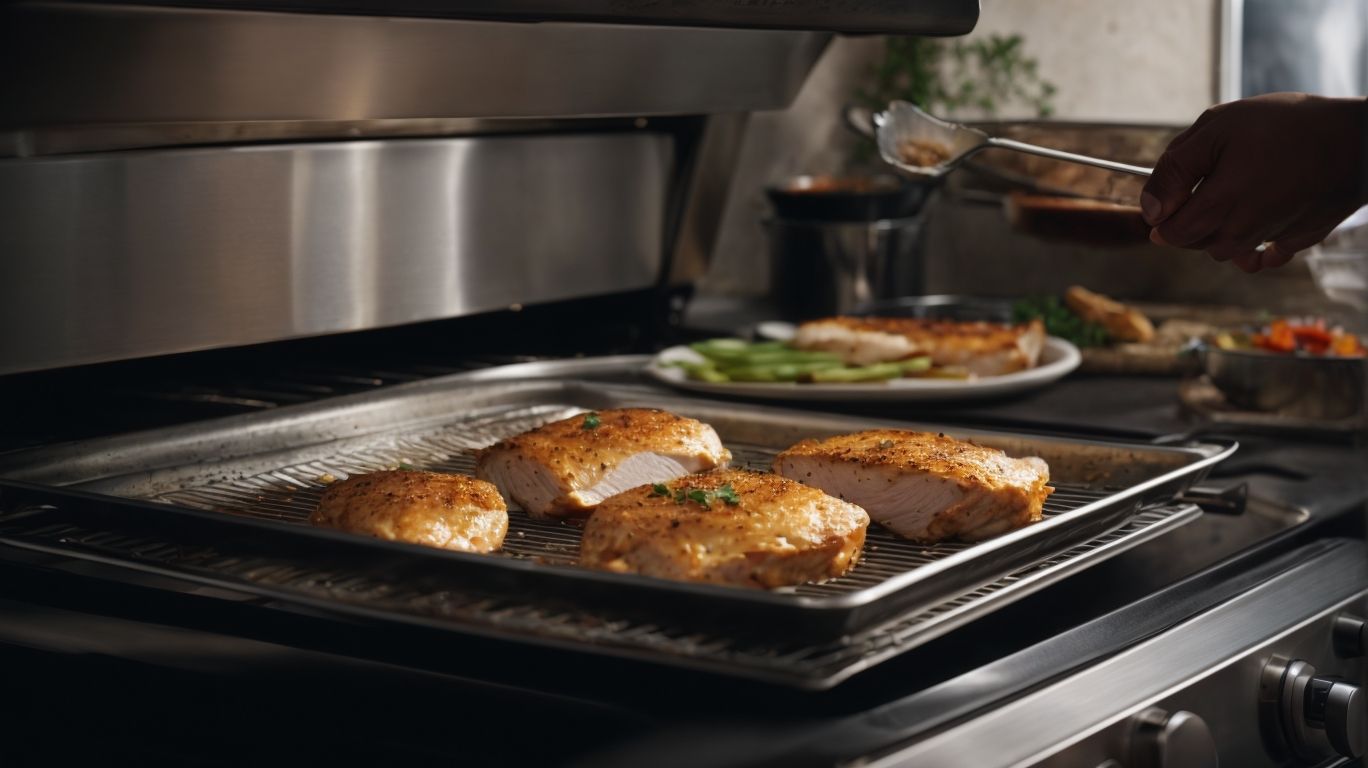
Credits: Poormet.Com – Gabriel Young
A broiler is a cooking appliance designed to expose food, such as chicken, to direct radiant heat for fast and efficient cooking.
This method of cooking using a broiler is similar to grilling but differs in that the heat source is directly above the food, cooking it quickly and giving it a delicious sear. Broilers are commonly found in ovens, either as a separate compartment in gas models or as a heating element on the top of the oven in electric models.
Broilers are versatile appliances that can be used to prepare a wide range of dishes beyond just chicken. Vegetables, seafood, and even certain cuts of beef can be cooked to perfection under the intense heat of a broiler.
How Does a Broiler Work?
A broiler functions by utilizing intense radiant heat from above to cook food rapidly, creating a crispy exterior while retaining moisture within the chicken.
This method of cooking in a broiler involves exposing the food directly to the high heat source, which can be electric, gas, or infrared, depending on the type of broiler. The intense heat penetrates the food quickly, sealing in the juices and flavors, while simultaneously producing that desirable caramelization on the outside. The proximity of the heat source ensures efficient cooking, making it ideal for foods that require a quick sear and intense heat, such as steaks, fish fillets, and vegetables. The radiant heat acts as a powerful cooking element, transforming the texture of the food and enhancing its overall flavor profile.
What are the Benefits of Cooking Chicken Breast Under Broiler?
Cooking chicken breast under a broiler offers numerous advantages, including quick cooking time, crispy texture, and juicy, flavorful results.
When using a broiler, the intense heat quickly sears the outside of the chicken breast, locking in moisture and creating that sought-after crispy outer layer while keeping the inside tender and juicy. The high temperature of the broiler cooks the chicken efficiently, making it a perfect option for those busy weeknights when you need a quick, satisfying meal. The direct heat from the broiler caramelizes the sugars in the chicken, enhancing the flavor profile and bringing out the natural savory elements.
Quick Cooking Time
One of the primary benefits of broiling chicken breast is the significantly reduced cooking time compared to other methods, ensuring a quick and efficient meal preparation process.
Broiling applies high, direct heat, cooking the chicken breast swiftly and evenly. This method eliminates the need for lengthy marinating or simmering, making it ideal for busy individuals. By positioning the chicken close to the heat source, the cooking time is further reduced. The heat quickly sears the outer layer, locking in moisture, resulting in tender and flavorful chicken breasts in a fraction of the time. The broiler’s intense heat mimics the effects of grilling, enhancing the taste and texture of the chicken. Quick cooking under high heat preserves the natural juices, keeping the chicken moist and succulent.
Crispy and Juicy Results
Broiling chicken breast leads to a delightful contrast of crispy exterior and juicy interior, enhancing the overall texture and flavor profile of the dish.
This cooking method involves exposing the chicken breast to high heat directly from above, allowing the outer layer to cook quickly and develop a satisfying crunch, while locking in the moisture within the meat. The intense heat caramelizes the surface, creating a crispy and flavorful crust that seals in the natural juices of the chicken. As a result, broiled chicken breast not only offers a textural delight but also ensures a succulent and tender eating experience, making it a favorite cooking technique for both home cooks and professional chefs.
Versatility in Cooking Methods
The flexibility of broiling as a cooking method offers versatility in preparing chicken breast with various seasonings, making it a versatile choice for creating diverse flavor profiles.
Broiling chicken breast allows for quick cooking at high temperatures, resulting in a juicy and flavorful dish. Whether you prefer a simple seasoning of salt and pepper or a complex blend of herbs and spices, the broiler can handle it all. The intense heat caramelizes the outer layer of the chicken, locking in moisture and enhancing the taste.
From classic lemon-herb to spicy barbecue, the broiler’s adaptability ensures that you can experiment with different flavor combinations to suit your mood or occasion. Broiling caters to various cooking styles; from marinating beforehand to basting during cooking, you have the freedom to customize your recipe according to your preferences.
What are the Tools Needed for Cooking Chicken Breast Under Broiler?
To cook chicken breast under a broiler effectively, essential tools such as a broiler pan, tongs, and a meat thermometer are essential for precise cooking and optimal results.
A broiler pan is specially designed to allow the chicken to cook evenly and to catch any drippings, preventing smoke and flare-ups that can occur when cooking directly on the rack.
Tongs play a crucial role in safely handling the hot chicken breast while turning and removing it from the broiler. The right tongs offer a firm grip and keep your hands away from the heat source.
A meat thermometer is a must-have tool to ensure the chicken breast reaches the safe internal temperature of 165°F. This guarantees that the chicken is thoroughly cooked, reducing the risk of foodborne illnesses.
Broiler Pan
A broiler pan is a specialized cooking tool designed to drain excess fats and allow even heat distribution when broiling chicken breast, ensuring optimal cooking results.
When cooking chicken breast, using a broiler pan is essential for achieving that perfect balance of crispiness and juiciness. The top grate of the broiler pan helps the chicken stay elevated, allowing the rendered fat to drip down to the bottom tray. This fat drainage not only reduces the greasiness of the chicken but also prevents any potential flare-ups in the oven. The design of the broiler pan ensures that the heat is evenly circulated around the chicken, promoting a well-cooked and delicious final dish.
Tongs
Tongs are essential cooking utensils for handling and flipping chicken breast during the broiling process, facilitating safe and efficient cooking.
When broiling chicken breast, using tongs ensures that you can easily maneuver the meat without risking burns from the intense heat of the broiler. The long handles of the tongs keep your hands safe from the heat source, allowing you to effortlessly turn the chicken for even cooking on both sides.
Additionally, tongs provide a secure grip, preventing any chances of the chicken slipping or falling during flipping. This control is crucial to avoid any splatters or injuries, maintaining a seamless cooking experience.
Meat Thermometer
A meat thermometer is a crucial tool for ensuring the chicken breast reaches the appropriate internal temperature during the broiling process, guaranteeing safe and perfectly cooked poultry.
Using a meat thermometer not only helps prevent undercooked chicken, which can lead to foodborne illnesses, but also avoids overcooking, which can result in dry and tough meat.
Cooking accuracy is paramount when it comes to poultry, as achieving the right temperature ensures both safety and optimal taste.
By monitoring the internal temperature with a meat thermometer, you can be confident that your chicken is not only safe to eat but also juicy and flavorful.
How to Prepare Chicken Breast for Broiling?
Preparing chicken breast for broiling involves steps such as thawing, seasoning with desired flavors, and ensuring the broiler is preheated for optimal cooking conditions.
Regarding thawing the chicken breast, it’s essential to do so safely. The best method is to place the chicken in the refrigerator overnight or use the defrost setting on the microwave. Once thawed, pat the chicken dry with paper towels to remove any excess moisture before proceeding with the seasoning.
Choose your favorite seasonings – whether it’s a simple mix of salt, pepper, and garlic powder or a more complex marinade, ensure that the chicken is evenly coated to enhance its flavor profile. Preheating the broiler is crucial to achieving that perfect sear and keeping the meat juicy inside.
Thawing the Chicken Breast
Thawing chicken breast thoroughly in the refrigerator before broiling is essential to ensure even cooking and minimize the risk of bacterial contamination.
Proper thawing allows the chicken breast to defrost evenly, which is crucial for consistent cooking. When chicken is thawed slowly in the refrigerator, it helps maintain the texture and juiciness of the meat. This method also prevents the growth of harmful bacteria, ensuring food safety. By giving the chicken enough time to thaw in the fridge, you also avoid the risk of partially cooked or unevenly cooked chicken, which can result from using other, quicker thawing methods. So, allowing the chicken breast to thaw in the refrigerator is a simple yet vital step in the preparation process before broiling.
Seasoning the Chicken Breast
Seasoning chicken breast with a blend of herbs, spices, and marinades enhances its flavor profile and creates a delicious taste experience when broiled.
Regarding seasoning chicken breast for broiling, the options are endless. You can go for a classic combination of garlic powder, paprika, and oregano for a Mediterranean touch, or opt for a zesty blend of lemon zest, thyme, and black pepper for a refreshing flavor. Seasoning not only adds depth to the taste but also tenderizes the meat, making it juicier and more succulent. The key is to allow the chicken to marinate for at least 30 minutes to allow the flavors to penetrate the meat fully.
Preheating the Broiler
Preheating the broiler ensures that the cooking environment is at the optimal temperature for searing and cooking the chicken breast efficiently.
When the broiler is not preheated, placing the chicken breast under it can result in an inadequate sear on the outside while leaving the inside undercooked. This could lead to a less than desirable texture and taste.
By preheating the broiler beforehand, you are setting the stage for the chicken to be quickly seared to lock in juices and flavors, while ensuring that it cooks evenly throughout. Achieving the right cooking conditions through preheating helps prevent the common pitfall of unevenly cooked meat, enhancing the overall dining experience.
How to Cook Chicken Breast Under Broiler?
Cooking chicken breast under a broiler involves placing the meat on a broiler pan, adjusting the rack position, and monitoring the cooking process until the desired doneness is achieved.
Before you start, ensure the chicken breast is at room temperature for even cooking. Season the chicken with your preferred herbs and spices for added flavor. Preheat the broiler, setting it on high for optimal results. Place the chicken on the broiler pan, skin side down, ensuring that there is enough space between each piece for uniform cooking.
Position the broiler rack about 5-6 inches away from the heat source to avoid burning the exterior without fully cooking the inside. Monitor the chicken closely, flipping it once halfway through to ensure even browning. Use an instant-read thermometer to check if the chicken has reached an internal temperature of 165°F.
Placing the Chicken Breast on the Broiler Pan
Placing the seasoned chicken breast on the broiler pan allows for even heat distribution during cooking, ensuring consistent and thorough broiling.
When you place the chicken breast on a broiler pan, the design of the pan allows the heat to circulate evenly around the meat. This is crucial for achieving that perfectly cooked chicken, as it ensures that every part of the breast is exposed to the same level of heat. Without a broiler pan, you risk uneven cooking where parts of the chicken may be overcooked while others remain underdone.
The elevated design of a broiler pan allows excess fat and juices to drip down, preventing the chicken from sitting in its own juices. This not only enhances the flavor by reducing sogginess but also promotes a crispy exterior, creating that desirable contrast in texture.
Broiling the Chicken Breast
Broiling the chicken breast under high heat setting in the broiler ensures a crispy exterior and juicy interior, requiring periodic checks for doneness during the cooking process.
Preheat your broiler to the recommended temperature, usually around 500°F (260°C), ensuring it is fully heated before placing the chicken breast on the top rack. Season the chicken breast with your preferred herbs and spices, drizzle with olive oil for added moisture, and place it on a broiler pan lined with foil for easy clean-up.
Position the chicken breast approximately 4-6 inches from the broiler element to allow for even cooking. Keep a close eye on the broiling process, flipping the chicken halfway through to ensure uniform browning, and using a meat thermometer to check for a safe internal temperature of 165°F (74°C).
Checking for Doneness
Checking the internal temperature of the cooked chicken breast with a meat thermometer ensures it has reached the recommended temperature for safe consumption.
Using a meat thermometer is crucial as it provides an accurate reading of the internal temperature, minimizing the risk of undercooked chicken, which can harbor harmful bacteria like salmonella. This simple step is essential to guarantee the chicken is cooked through, juicy, and safe to eat. Relying solely on visual cues or cooking time may not always guarantee the desired doneness, while the precise temperature measurement from a meat thermometer ensures cooking accuracy. Food safety experts emphasize the importance of avoiding guesswork when it comes to cooking poultry, making a thermometer an essential tool in every kitchen.
What are Some Tips for Cooking Chicken Breast Under Broiler?
To achieve perfect results when cooking chicken breast under a broiler, consider using high heat, monitoring the cooking progress, and allowing the meat to rest before serving for optimal flavor.
Regarding broiling chicken, remember that high heat is your friend. Before you start, position the oven shelf so the top of the chicken breast is approximately 6 inches away from the broiler element for efficient cooking. Keep a close eye on the chicken as it cooks – timings can vary depending on the thickness of the meat, so monitoring is key. Once the chicken is cooked to perfection, let it rest for a few minutes before slicing or serving to lock in those delicious juices and flavors.
Use High Heat
Utilizing high heat setting in the broiler ensures a quick sear and flavorful caramelization on the chicken breast, enhancing its overall taste and texture.
Besides the irresistible flavor boost, the high heat setting in the broiler also plays a vital role in locking in the juices of the chicken breast, keeping the meat moist and tender. This method accelerates the cooking process, making it an efficient option for busy weeknights when you’re craving a delicious and home-cooked meal.
The intense heat helps achieve that coveted crispy exterior while maintaining a juicy interior, resulting in a perfectly cooked chicken breast with a delightful contrast in textures.
Keep an Eye on the Chicken Breast
Regularly monitoring the chicken breast during the broiling process prevents overcooking and ensures the meat reaches the desired level of doneness for optimal juiciness.
When you are broiling chicken, it’s crucial to keep a close eye on it to prevent the risk of dry, tough meat. By staying vigilant and checking on the chicken periodically, you can ensure that it cooks evenly and retains its natural moisture. Timing plays a significant role in broiling, so monitoring the chicken throughout the process allows you to adjust as necessary for perfect results. Remember that broilers can vary in intensity, so knowing how your equipment works and adapting your cooking accordingly is essential for achieving tender, succulent chicken.
Let the Chicken Breast Rest Before Serving
Allowing the cooked chicken breast to rest before serving helps redistribute juices within the meat, resulting in a tender and flavorful final dish.
During the resting period, the residual heat continues to gently cook the chicken, ensuring that it remains succulent and moist. This process also allows the flavors to meld and intensify, enhancing the overall taste experience.
When ready to serve, consider slicing the rested chicken breast against the grain to maximize tenderness. Pair it with vibrant fresh salads, creamy mashed potatoes, or fragrant rice pilaf for a well-rounded meal.
Frequently Asked Questions
1. How do I properly prepare chicken breast for cooking under the broiler?
To prepare chicken breast for cooking under the broiler, start by trimming off any excess fat and seasoning the chicken with salt, pepper, and any desired herbs or spices. Make sure the chicken is at room temperature before cooking.
2. What type of pan should I use when cooking chicken breast under the broiler?
It’s best to use a shallow, oven-safe baking dish or a broiler pan with a rack. This allows for even cooking and prevents the chicken from sitting in its own juices.
3. What temperature should I set my broiler to when cooking chicken breast?
For chicken breast, it’s important to use the high broil setting and preheat the broiler for at least 5 minutes. This will ensure a crispy and evenly cooked chicken breast.
4. How long does it take to cook chicken breast under the broiler?
The cooking time will vary depending on the thickness of the chicken breast, but on average it takes about 6-8 minutes per side. To be sure, use a meat thermometer and make sure the internal temperature reaches 165°F (74°C).
5. Can I marinate chicken breast before cooking it under the broiler?
Yes, marinating chicken breast before cooking under the broiler is a great way to infuse flavor and keep the chicken moist. Just be sure to pat the chicken dry before cooking to avoid excess liquid under the broiler.
6. Are there any safety precautions I should take when cooking chicken breast under the broiler?
Yes, it’s important to handle and cook chicken properly to avoid foodborne illness. Always wash your hands before and after handling raw chicken and make sure to cook it to an internal temperature of 165°F (74°C). Also, be sure to clean any surfaces or utensils that come in contact with raw chicken.

